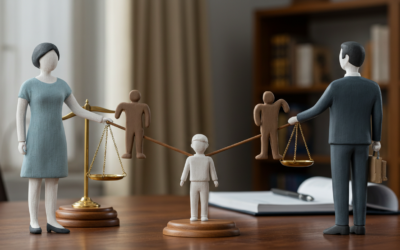Domestic violence remains a stark reality, impacting lives with alarming frequency. According to the Wisconsin Domestic Violence Homicide Report, in Wisconsin alone, the disturbing trend saw 96 lives lost in 2022, reflecting a 20% surge from the previous year. This chilling rate of nearly one death every 3.8 days positions Wisconsin as eighth nationally for the number of women tragically killed by men.
These figures underscore the critical need for victims to understand and utilize protective measures like restraining orders. A restraining order is a legal decree issued by a court to protect a person from harassment or harm. It is a barrier between the victim and the abuser, offering a semblance of safety in a world that often feels perilously unpredictable.
Read on as we shed light on the significance of restraining orders and guide victims through the process of obtaining one.
Understanding Domestic Violence
Domestic violence refers to a pattern of behavior in any relationship used to gain or maintain power and control over an intimate partner. This abuse can manifest in various forms, including the following:
Control: Control in domestic violence refers to behaviors aimed at diminishing the victim’s independence and self-esteem. This includes monitoring their movements, dictating their appearance, or limiting their access to information.
Physical abuse: Physical abuse involves any use of force that causes injury or fear. It ranges from slapping and hitting to severe physical harm.
Sexual abuse: Sexual abuse includes any non-consensual sexual activity, ranging from unwelcome sexual comments to sexual assault.
Emotional abuse and intimidation: This type of abuse involves undermining the victim’s sense of self-worth, often including constant criticism, belittling, and intimidation.
Isolation: Isolating a victim from friends, family, and support systems is a tactic to increase dependence on the abuser.
Verbal abuse: Verbal abuse encompasses coercion, threats, and blame, using words to demean and frighten the victim.
Economic abuse: Economic abuse involves controlling a victim’s access to financial resources, hindering their ability to be self-sufficient, and forcing dependence on the abuser.
The signs and symptoms of domestic violence can vary, but often include the following:
- Unexplained injuries or frequent “accidents”
- Withdrawal from usual activities
- Isolation from friends and family
- Lack of access to money or personal documents
- Fear of the partner expressed through anxiety or nervousness around them
- Diminished self-esteem and self-worth
What is a Restraining Order?
A restraining order is a legal document issued by a court to protect an individual from abuse, harassment, or harm. It is a crucial tool in the fight against domestic violence and other forms of personal threat, setting legal boundaries for the perpetrator’s behavior.
Types of Restraining Orders
In Wisconsin, there are four primary types of restraining orders, each tailored to address specific situations:
Domestic abuse orders: These are for individuals who have experienced physical harm, threat, or sexual assault by a family member, household member, or a current/former intimate partner.
Harassment orders: Harassment restraining orders are applicable when someone faces stalking, repeated harassment, or intimidation that causes emotional distress or fear for personal safety.
Child abuse orders: These protective orders safeguard children from physical, emotional, or sexual harm by a parent, guardian, or other individuals.
Individuals at risk orders: These protect individuals at risk, including those who are elderly or have physical or mental limitations that make them susceptible to abuse or exploitation.
Individuals who can apply for a restraining order include those who have experienced or are at risk of experiencing abuse, harassment, child abuse, or any harm from someone with whom they share a specific relationship (as defined by the type of order). The restraining order provides immediate and enforceable legal safeguards for victims, affirming their right to safety and personal security.
The Process of Obtaining a Restraining Order
Here is a step-by-step guide to obtaining a restraining order in Wisconsin:
Filing the Petition
The first step is to file a petition for a restraining order at your local county clerk of courts office. This petition requires detailed information about the abuser (respondent) and specific incidents of abuse or harassment. Upon filing, a judge or court commissioner reviews the petition.
Temporary Restraining Order (TRO)
Once the petition is filed, a judge may issue a Temporary Restraining Order (TRO) if they believe there’s an immediate threat. This order is usually granted without the presence of the abuser and remains in effect until the full court hearing.
Service of Notice and Injunction Hearing
The respondent must be notified of the TRO and the scheduled date for the injunction hearing. The sheriff serves this notification, along with the TRO.
Injunction Hearing
During the hearing, both the petitioner and the respondent have the opportunity to present evidence and explain their side to the judge or court commissioner.
Court’s Decision
After evaluating the evidence and arguments from both sides, the court decides whether to grant or deny the injunction. If granted, the injunction replaces the TRO and offers longer-term protection, generally ranging from two to ten years, depending on the case’s specifics.
Living with a Restraining Order
Living with a restraining order provides a crucial shield for victims of abuse or harassment. To enforce it, any violation by the abuser must be promptly reported to law enforcement. The police can take immediate action, which may include arresting the violator.
Violating a restraining order carries serious consequences, often resulting in criminal charges that can lead to fines, probation, or jail time. For the victim, the restraining order affirms legal rights and protections, ensuring safety and peace.
Resources for Victims of Domestic Violence
Here are some of the resources that provide support, information, and services crucial for the safety and recovery of domestic violence victims:
National Resources
- National Domestic Violence Hotline: You can contact them at 1-800-799-SAFE (7233)
- National Coalition Against Domestic Violence (NCADV)
- The National Resource Center on Domestic Violence (NRCDV)
Wisconsin Local Resources
- End Domestic Abuse Wisconsin.
- Wisconsin Coalition Against Sexual Assault (WCASA)
- Wisconsin Department of Children and Families
Local shelters in Wisconsin provide safe housing and support services. Victims can access these through local directories or by contacting End Domestic Abuse Wisconsin. Individual and group counselling services are available statewide, offering emotional support and therapy for victims and their families.
Seek Legal Support From Vanden Heuvel & Dineen, S.C
Understanding and securing a restraining order is a pivotal step for those facing domestic violence. It’s a legal affirmation of your right to safety and a barrier against ongoing abuse. If you are a victim of domestic violence, seek help and utilize the various resources available, from national hotlines to local shelters and counseling services.For those in Wisconsin, partnering with a criminal defense lawyer from Vanden Heuvel & Dineen, S.C., can provide the specialized guidance and support needed to navigate these challenges. Our experienced team offers expert advice, helping you effectively understand and exercise your legal options. Contact us today to learn how we can help.




